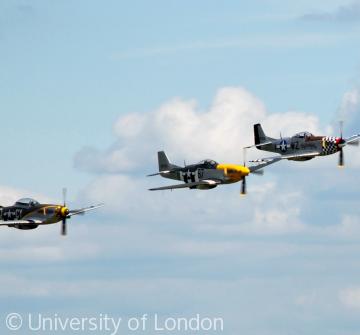The Second World War
 Three P-51 Mustangs fly in formation over the former RAF base at Duxford, Cambridgeshire
Three P-51 Mustangs fly in formation over the former RAF base at Duxford, CambridgeshireThe Second World War (also known as World War II) involved most of the world's nations, including all of the great powers, organised into two opposing military alliances: the Allies and the Axis. The war officially began in September 1939, when Nazi Germany invaded Poland, and France and Britain subsequently declared war on Germany.
In late 1939 Britain began its evacuation programme, in anticipation of the bombing of its towns and cities. Almost three million children were transported to the relative safety of homes in the country. Thirty children and two teachers from Peckham, London, were evacuated to Parham House in Sussex, many of them visiting the countryside for the first time. They stayed at Parham until 1942 when they were rehoused in the nearby village of Storrington. Parham, in the middle of the South Downs Training Area, also became a base for Canadian soliders, stationed in huts in Parham Park, with their headquarters based in the great hall. Many country estates were expected to support the war effort in this way during the Second World War, and garrisoned troops became a regular feature across the English landscape.
The village of Codford in Wiltshire again became a training and convalescence base for a number of troops, including US servicemen. There are many reminders that Americans were stationed in the parish, including an amateur mural painted in the Woolstore by soldiers who used the building as their Sergeants’ Club. Between 1941 and 1944, the renowned artist Rex Whistler was stationed at Codford. During his time there he transformed the interior of the squalid officers’ mess, painting the inside as a Bedouin tent. Sadly this building was destroyed when the Codford camps were dismantled. However, the remains of a row of wheeled vehicle repair workshops operated by the Royal Electrical and Mechanical Engineers are still visible and are one of the few structures from the Second World War to survive into the 21st century.
Exmoor, like Salisbury Plain, was used for infantry and artillery training during the Second World War, turning the landscape into a battleground. The Royal Observer Corps, British and American troops, searchlight positions, anti-aircraft batteries, artillery ranges, gunnery ranges and tank training all occupied open ground on Exmoor. The noise of gunfire, shells and mortars was a constant background to life on the moor. Many local men joined the Local Defence Volunteers and the Women's Land Army went to work on the farms, raising crops such as corn and potatoes. Child and adult evacuees accounted for an additional 856 members of the parish in 1940. In 1944 several thousand American troops, including one General Eisenhower, arrived at Dulverton station in preparation for D Day.
The war ended with the victory of the Allies in 1945, leaving the political and social structure of the world changed forever. The Second World War was the largest and most destructive in history, involving more than 100 million military personnel and resulting in over seventy million casualties across the world.









